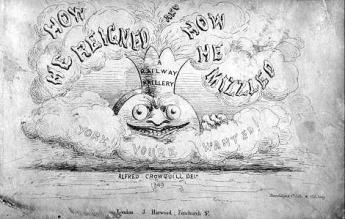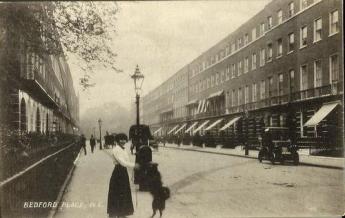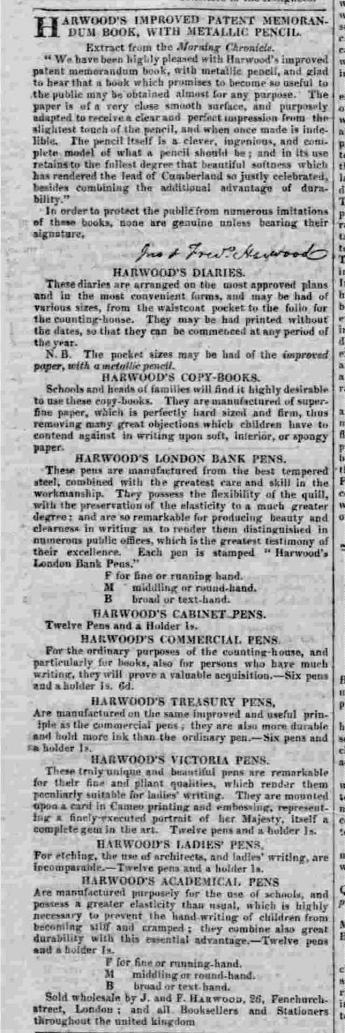Antiquarian Booksellers' Association Ash Rare Books
Collecting - J. & F. Harwood of Fenchurch Street

By Laurence Worms
I have long admired those occasionally found sheets of decorative Victorian notepaper – a handsomely engraved view of your place of resort at the head of a folded sheet of letter-paper: enough space to write a full four-page letter – the more leisurely and elegant precursor of the picture-postcard. While they enjoyed their brief spell of fashion in the mid-nineteenth century there were a number of specialist London (as well as local) manufacturers, but the most appealing of them to my mind – a little larger, a little more artistic – employing decent artists like Thomas Abiel Prior and Edward John Roberts, and certainly better engraved – were those produced by the Harwoods of Fenchurch Street, who also produced bound selections of these views printed on heavier paper under a multitude of titles, such as “Harwood’s Scenery of Great Britain”, “Harwood’s Views of Guernsey”, “Harwood’s Views of Derbyshire”, etc.
No-one seems to know anything much about the Harwoods and having acquired a small selection of their decorative notepaper recently (as well as having spent a large chunk of my own working life in and around Fenchurch Street – in a shop just off it and in an office actually on it) I thought I would take the time to investigate. What I did not know when I used to gaze down Rood Lane from my old office window, is that 150 years earlier I would have been able to wave to the Harwoods across the road – their premises at No. 26 (long since disappeared) were directly opposite mine at No. 153 (the street numbering is idiosyncratic).
The Harwoods were general and wholesale stationers offering a much wider range of stock than just decorative notepaper: they were booksellers, publishers, printers, pen-dealers, pocket-book makers, bookbinders and engravers (or at least they took in bookbinding and engraving work). Theirs was often an innovative range. They patented designs for pens and inkstands. They were the manufacturers of the “improved patent metallic memorandum books” – the metallic paper described as “indelible”. They also produced their Diamond Diaries, “sufficiently small for the waistcoat pocket”. Their range of pens included bank pens, cabinet pens, commercial pens, treasury pens, Victoria pens, ladies’ pens and academical pens.
Their publishing, beyond books of views and tourist guides, was often interesting, quirky, humorous and entertaining. They published “How Fanny Teaches her Children” (1836) by Harriet Downing; “The Tutor’s Assistant, or, Comic Figures of Arithmetic” (1843) by the caricaturist “Alfred Crowquill” (Alfred Henry Forrester), as well as his comic “A Guide to the Watering Places”. Later publications by John Harwood alone included Percy Cruikshank’s undated “Hints to Emigrants, or, Incidents in the Emigration of John Smith of Smith Town : Consisting of Nine Humorous Illustrations”; “The Pictorial Cabinet : An Entertaining and Literary Miscellany” (1846); Crowquill’s “Pantomime : As It Was, Is, and Will Be : To Be Played at Home” (1849) and the splendid “How He Reigned and How He Mizzled. A Railway Raillery” (1849) – caricatures on the career and scandal of George Hudson, the Railway King.
John Harwood (1798-1855) was the senior partner, born 24th March 1798 in the London parish of St. Marylebone, the son of James Harwood, a butcher, and his wife Sarah. He was apprenticed in 1813 to the stationer James Low of Chancery Lane, proprietor of a circulating library, for the handsome sum of £80. He had set up for himself in Fenchurch Street by 1822 – a trade-card from this period survives in the British Museum. The younger Frederick Harwood, seemingly a cousin of some sort rather than a younger brother, became a partner in 1830 and the business traded as “J. & F. Harwood” until the partnership was formally dissolved on 12th January 1844: stresses and strains must have become apparent six months earlier when the company was declared bankrupt on 13th July 1843. The financial difficulties were evidently temporary, as the bankruptcy was formally annulled at the time of the dissolution of the partnership, but henceforth John Harwood traded once more on his own account.
John Harwood had married Mary Ann Catherine Hudden (1818-1896), daughter of William and Catherine Hudden, her father described simply as a gentleman, at St. Mary Haggerston on 11th April 1838. The newly married couple evidently lived over the shop at 26 Fenchurch Street. The 1841 Census captures them there with two infant daughters, Mary Ann and Emily. Further children were to arrive in the ensuing years: Jessie Maria Harwood, who died in infancy, John Augustus Harwood and Ellen Adine Harwood. The firm rapidly recovered from the short period of bankruptcy and the termination of the partnership. By 1851 John Harwood was employing no less than forty men in what must have been an extensive line of business. He died on 1st June 1855, evidently leaving his widow comfortably off.
Mary Ann Catherine Harwood saw out her days living in Bedford Place, one of London’s most elegant streets, perhaps quietly supplementing her income with some genteel paying guests. Her son John Augustus Harwood became a barrister and her daughter Emily married another.
The junior partner, Frederick Harwood (d.1861), is an altogether more shadowy figure. The 1861 Census finds him at 6 Mildmay Villas in Islington, recording him as a man of independent means, originally from Wiltshire and sixty years of age. I can find no trace of his birth in or about 1801, in Wiltshire or elsewhere, and the fact that he was not apprenticed until 1822 suggests that he may well have been born a few years later than that. His apprenticeship (probably served with John Harwood) finished in 1829 and he had become a partner in “J. & F. Harwood” by 1830. He married Clara Nash, originally from Ludlow, at Holborn in 1836.
What became of him after the dissolution of the partnership early in 1844 I am unable to tell, although he may perhaps have continued working in the business in a more junior position. I have not been able to trace a will for John Harwood, but Frederick may have been a beneficiary. Shortly after John’s death in June 1855, Frederick announced a new coloured weekly newspaper, “Colored News”, to be published from 183 Fleet Street at 2d a week with “richly painted engravings”. The price seems improbably low for something with hand-coloured engravings of all the weekly round of sensational news – fires, murders, battles, storms, shipwrecks, earthquakes, duels, trials, accidents, elopements, insurrections, robberies, executions – all these and more were promised.
A “Colored Songster” featuring the best songs of the day was also announced. By September the price of the already cheap “Colored News” had halved to a penny, but the venture was evidently a spectacular failure. No more is heard on either score. Frederick died at Mildmay Villas on 10th December 1861, leaving an estate of under £200.
***
Posted on The Bookhunter on Safari, presented here by permission of the author. Pictures: The Bookhunter on Safari.




